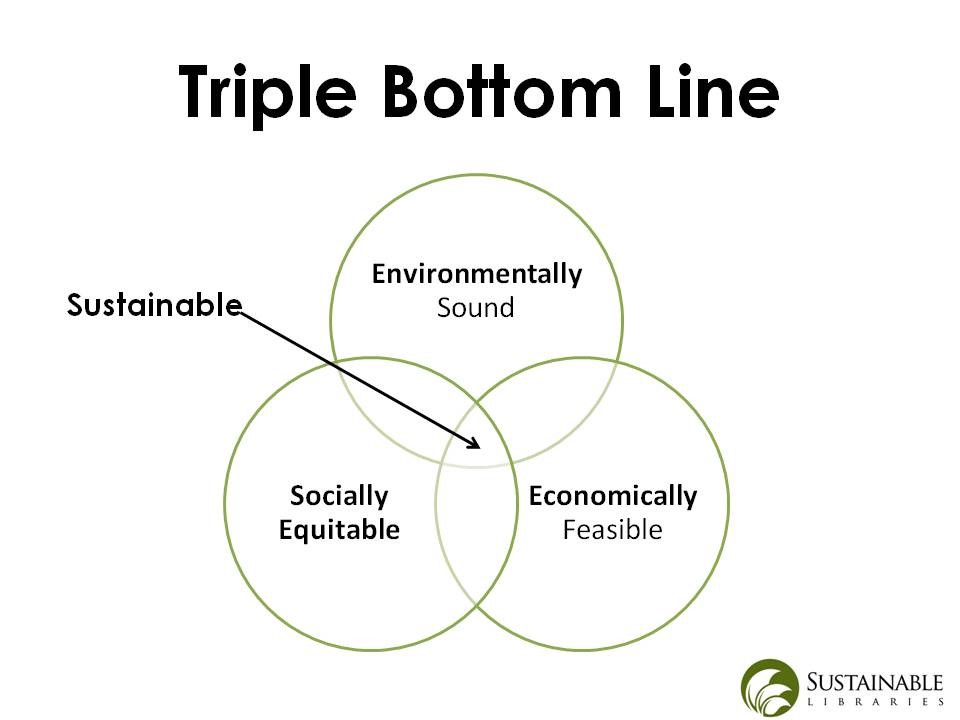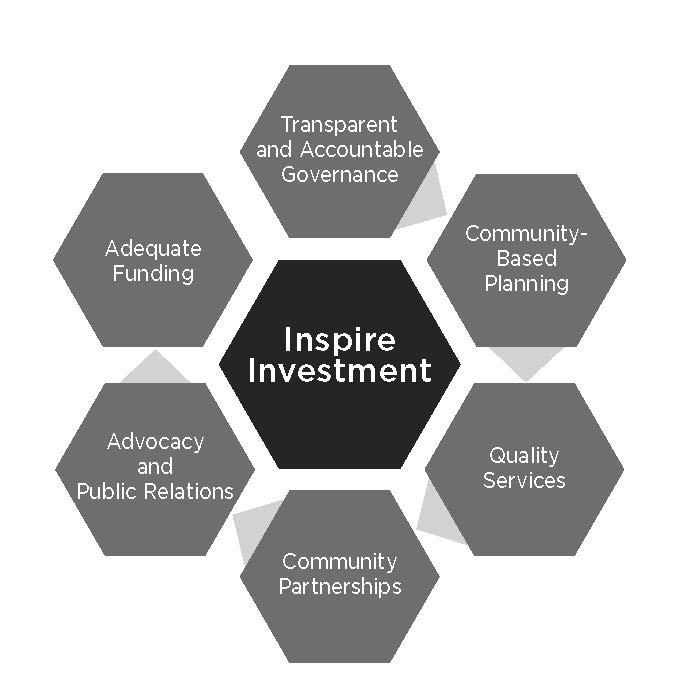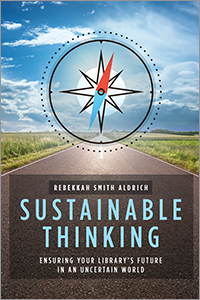Ensuring libraries' future through sustainable thinking: an interview with Rebekkah Smith Aldrich
For the past several years the library world has been abuzz with the concept of "sustainable thinking." Yes, we all want to help the environment and also ensure that libraries are on board too. But beyond being just a feel-good catchphrase, how does sustainable thinking translate into concrete action? Rebekkah Smith Aldrich explores exactly that in her new book, and in this interview she discusses how many libraries are taking the initiative in areas ranging from community outreach and programming to building design.
You've done quite a bit of writing for various publications, including your regular column for Library Journal, but this is your first book. What was different about doing this kind of long-form piece? What were your biggest challenges?
At first, I thought to myself, no problem, it's just like writing a series of articles like I do for Library Journal. I did the math, figured out my word count and went for it. But that approach really didn't work. There is an element of storytelling necessary to make the case, build buy-in and inspire people to keep reading so they are primed for the work ahead.
It took me several tries to find the right "arc" to the story. Each chapter required that I have a plan, that I was purposefully helping the reader walk through the story as it had evolved for me over the past decade. Ensuring I carried the thread throughout the work rather than writing several 800-word essays that might come across as disjoined was important. The work was to balance the enormity of the topic with a call to action that then led the reader to pragmatic steps that library leaders could relate to, regardless of the size of their library. Keeping things simple, well-defined and justified definitely took more time than I had anticipated.
How did your experience as a founding member of New York Library Association's Sustainability Initiative guide your book?
Thanks to the NYLA Sustainability Initiative (NYLA-SI) I have had the opportunity to think out loud and to get honest feedback from my peers. That was incredibly helpful while writing the book. I would throw ideas out  there sometime and get the thumbs up, other times... crickets. That's when I knew I wasn't connecting on a particular point. That peer feedback has been invaluable.
there sometime and get the thumbs up, other times... crickets. That's when I knew I wasn't connecting on a particular point. That peer feedback has been invaluable.
The other great thing about the SI is that I get invited to speak on the topic all over the state. I've been able to fine tune my talking points and get real time reactions from hundreds of library leaders - directors, staff and trustees. It has also meant that I have a front row seat to what is going on around our state and get first-hand accounts of what's working, what's not and what challenges leaders are coming up against. That inspires me to ensure the work I'm doing is as relevant as possible. The theory of this stuff really only gets us so far. If library leaders don't have examples to draw from, success stories to point to and sparks of inspiration to get them going we can't accelerate fast enough to meet the challenges that are facing us.
What we routinely hear from library leaders after an introductory workshop is: "What do I do next?" That drove me to stop just pontificating and our committee has really thought through how a library leader would proceed. We are talking about a huge mindset shift for not just individuals but whole institutions. While I have great faith in my colleagues to do this work, we can all use some help and guidance to accelerate the pace of what needs to happen. There is a definitely sense of urgency that is lacking in the profession. If people feel too overwhelmed they will be immobilized. The experience with NYLA-SI has taught me to break it down into bite-sized chunks and develop step-by-step assistance to help library leaders ramp up on the issue.
The NYLA-SI has been a huge reality check for me: even in the face of such a large topic we must keep things simple.
One of the foundational ideas in your book is that the sustainability of libraries, which is extremely dependent on things like community support and visionary leadership, has a close relationship to the sustainability of our planet. Would you briefly explain why you believe the two are so intertwined?
As Rachel Carson famously said in Silent Spring, "Nothing in nature exists alone." Libraries do not exist alone. Library leaders do not exist alone. We are all connected to the wider world around us. As libraries we need to be embedded, in an authentic and meaningful way, into the lives of those we serve. That means understanding the status of the building blocks of life, that means awareness of the wider world around us. The library is how we translate our desire to be of service to our fellow citizens. We cannot be relevant if we do not understand what people are currently dealing with or facing in the future.
If we are to truly convey to those we serve that we care about their well-being and that we are trusted institution that are good stewards of their trust and tax dollars there needs to be an inherent commitment in our libraries to environmental sustainability. If we are careless with natural resources, if we do not respectfully dispose of unwanted items, if we do not help to educate others of the effects of our actions on the natural world there will not be much left for us to do in a few decades other than disaster response. We will be on the front lines of helping more and more citizens with what may have been preventable problems or issues we should have learned to adapt to.
At a time when it seems like many libraries are stuck in a perpetual battle for survival, a yearly fight just to stave off cuts in funding, how do issues like social equity and justice come into play?
It's tough out there, financially, politically and socially. The only way forward on any of those topics - for both  libraries and communities - is for libraries to actively co-create communities in which citizens have respect, understanding and empathy for one another.
libraries and communities - is for libraries to actively co-create communities in which citizens have respect, understanding and empathy for one another.
Funding doesn't come from a machine, it comes from people. Whether that be from direct taxpayer decisions in the voting booth, municipal governments that allocate a portion of their budget or private donations - people are behind the decisions about library funding.
Library leaders are responsible for not only creating library services and programs that inspire the community to invest in the library, but to work collaboratively with their neighbors to help their community thrive. The coalition building, the partnerships that help realize shared goals in the community - that is what inspires opinion leaders and decision makers to invest scarce tax dollars into our libraries. You can't only venture out of your library and speak to others when you need something. You need to be genuinely invested in the community's success and a community cannot be successful if it is not socially equitable.
In the book there is a chapter on what I call the "Three Es of Sustainable Libraries": Empower, Engage, Energize. These three actions describe how library leaders should approach their work to inspire people inside of the library organization and community members. In twenty years what I have observed is that this attitude in how we interact with others has a fascinating energy exchange - if your work is focused on empowering, engaging and energizing others they, in turn, will do the same for your library. I have found this to be a "secret ingredient" for many of the most successful libraries I have worked with.
What are some pieces of advice you can offer libraries about more effectively demonstrating and communicating their importance to the communities they serve?
First I believe we need to "walk the walk." We cannot just tell people we are committed to intellectual freedom, diversity, social responsibility or the other Core Values of Librarianship - we need to "live it." Our policies and practices should reflect our commitment to these values. How we spend funds on behalf of the community should reflect our commitment to these values. The partnerships, programs and services we create should reflect our commitment to these values.
Examples of this can include simple things, like the food we serve at events - is it healthy? Locally sourced? - to more complicated things like how we operate our facilities or how we build new facilities. Is human health obviously valued in these choices? Are natural resources respectfully utilized? Are we humane to our staff? Do they make a living wage? Do they have access to affordable healthcare? Are our services and programs designed to advance larger community goals? Do our boards of trustees reflect the diversity of the community that we serve? These are just a handful of examples of the non-verbal choices we make that communicate what kind of organization we are.
In traditional communication channels - annual reports to the community, newsletters, social media - it is imperative that we, ourselves, state why we do the things that we do. I feel libraries make too many assumptions about what the community-at-large truly understand about the work that we do. We need to state that we are contributing to economic development by doing x, y, x. We need to clearly articulate our values. If we don't do it, no one else will. There is no one else but ourselves to blame for our mushy messaging over the past twenty years. We need to get better at this, and fast, if we want to continue to maintain and grow our capacity to be a positive force in the world. That is a major theme of the book and I spend a lot of time delving into this.
What are some promising changes in the library world that give you hope for the future?
I see so many awesome things happening in our world right now! A great example is that the fine free debate is finally graduating from a financial issue to a social equity issue. I am so impressed by my  colleagues who have stood up for their communities to make the case that fines are a barrier to access for children in poverty.
colleagues who have stood up for their communities to make the case that fines are a barrier to access for children in poverty.
The Living Building Challenge was on the cover of Library Journal last year, that is a huge statement that the library profession is paying attention to the right things. I'm also keeping my eye on Hayward (CA)'s 21st Century Library project; when completed, Hayward's new library will be among the largest "Zero Net Energy" public buildings in the nation.
The makerspace/breakerspace/repair café movement is so inspiring. I love that we are challenging people of all ages in our communities to learn how things work, to fix their own stuff, to create and invent new things and methods. In the book I talk about how critical it will be for us to inspire people to work together to find community-based solutions so we can adapt in the face of some pretty severe disruptions that are headed our way (and some are already here). We cannot be effective at this unless we cultivate a spirit of innovation and collaborative problem solving. I get seriously annoyed when I hear library leaders that are dismissive of this trend as just the latest "shiny." This is one of the greatest examples of how libraries empower their communities and future generations. It is one of the best talking points out there of how libraries contribute to sustainable, resilient and, ultimately, regenerative communities.
The number one thing that gives me hope is the spirit and fortitude of my colleagues and the volunteer trustees that govern our libraries. People who keep trying. People who keep innovating. People who keep fighting for the right things on behalf of those we serve. We are all in this together, both in library world and more important, in the big wide world around us. Libraries are critical partners to the success of our communities and it is an exhilarating time to be a part of this work.
Sustainable Thinking: Ensuring Your Library's Future in an Uncertain World is available at the ALA Store
